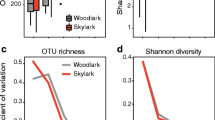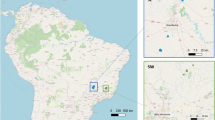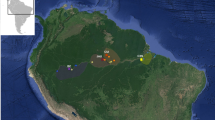Abstract
We used molecular methods to determine the microbial community of soil and avian plumage across biogeographic, ecological, and taxonomic scales. A total of 17 soil and 116 feather samples were collected from five avian species across multiple habitat types within one Neotropical and one temperate locality. Hypotheses regarding patterns of microbial composition relative to acquisition and dispersal of plumage bacteria in the ecosystem were tested by comparing microbial communities within and between soil and plumage. Samples from the plumage of American Redstarts (Setophaga ruticilla) were collected across both habitat types and geographic scales for intraspecific comparisons. The microbial diversity in avian plumage was moderately diverse and was dominated by Pseudomonas species. Despite a highly significant individual bird effect on microbial composition of the plumage, we detected significant biogeographic and type of habitat effects. Pseudomonas species were more abundant on the temperate site when all avian species were included in the analysis, and Bacillus subtilis and Xanthomonas groups were more abundant on the Neotropical site for redstarts alone. However, 16S rDNA sequence libraries were not significantly different between Jamaican and Maryland redstarts. Biogeographic and habitat effects were significant and more pronounced for soil samples indicating lower dispersal of soil microbiota. We detected a significant difference between soil and plumage microbial communities suggesting that soil plays a small role in plumage bacterial acquisition. Our results suggest bacterial communities on the plumage of birds are dynamic and may change at different stages in a bird’s annual cycle.






Similar content being viewed by others
References
Atkins, MS, Teske, AP, Anderson, OR (2000) J Eukaryot Microbiol 47: 400
Baas-Becking, LGM (1934) Geologie of Inleiding Tot de Milieu-kunde. WP Van Stokum, The Hague, The Netherlands
Bray, JR, Curtis, JT (1957) An ordination of the upland forest communities of Southern Wisconsin. Ecol Monogr 27: 325–349
Broughton, LC, Gross, KL (2000) Patterns of diversity in plant and soil microbial communities along a productivity gradient in a Michigan old-field. Oecologia 125: 420–427
Buckely, D, Schmidt, T (2001) The structure of microbial communities in soil and the lasting impact of cultivation. Microb Ecol 42: 11–21
Burtt, EH Jr (1999) Think small. Auk 116: 878–881
Burtt, EH Jr, Ichida, JM (2004) Gloger’s Rule, feather-degrading bacteria, and color variation among Song Sparrows. Condor 106: 681–686
Burtt, EH Jr, Ichida, JM (1999) Occurrence of feather-degrading bacilli in the plumage of birds. Auk 116: 364–372
Burtt, EH Jr, Chow, W, Babbitt, GA (1991) Occurrence and demography of mites of tree swallow, house wren, and eastern bluebird nests. In: Loye, JE, Zuk, M (Eds.) Bird–Parasite Interactions: Ecology, Evolution, and Behaviour, Oxford University Press, Oxford, pp 104–122
Cho, JC, Tiedje, JM (2000) Biogeography and degree of endemicity of fluorescent Pseudomonas strains in soil. Appl Environ Microbiol 66: 5448–5456
Clarke, KR, Gorley, RN (2001) Primer v.5: User Manual/Tutorial. PRIMER-E, Plymouth Marine Laboratory, UK
Clayton, DH (1991) Coevolution of avian grooming and ectoparasite avoidance. In: Loye, JE, Zuk, M (Eds.) Bird–Parasite Interactions: Ecology, Evolution, and Behaviour, Oxford University Press, Oxford
Clayton, DH, Price, RD (1999) Taxonomy of New World Columbicola (Phthiraptera: Philopteridae) from the Columbiformes (Aves), with descriptions of five new species. Ann Entomol Soc Am 92: 675–685
De Deyn, GB, Van der Putten, WH (2005) Linking aboveground and belowground diversity. TREE 20: 625–633
DeLong, EF, Karl, DM (2005) Genomic perspectives in microbial diversity. Nature 437: 336–342
Fall, S, Nazaret, S, Chotte, JL, Brauman, A (2004) Bacterial density and community structure associated with aggregate size fractions of soil-feeding termite mounds. Microb Ecol 48: 191–199
Finlay, BJ (2002) Global dispersal of free-living microbial eukaryote species. Science 296: 1061–1063
Finlay, BJ, Clarke, KJ (1999) Ubiquitous dispersal of microbial species. Nature 400: 828
Gagnevin, L, Leach, JE, Pruvost, O (1997) Genomic variability of the Xanthonomas pathovar mangiferaeindicae, agent of mango bacterial black spot. Appl Environ Microbiol 63: 246–253
Graham, JM, Kent, AD, Lauster, GH, Yannarell, AC, Graham, LE, Triplett, EW (2004) Seasonal dynamics of phytoplankton and planktonic protozoan communities in a northern temperate humic lake: diversity in a dinoflagellate dominated system. Microb Ecol 48: 528–540
Grant, A, Ogilvie, LA (2004) Name that microbe: rapid identification of taxa responsible for individual fragments in fingerprints of microbial community structure. Mol Ecol Notes 4: 133–136
Green, JL, Holmes, AJ, Westoby, M, Oliver, I, Briscoe, D, Dangerfield, M, Gillings, M, Beattie, AJ (2004) Spatial scaling of microbial eukaryote diversity. Nature 432: 747–750
Hawkins, BA, Porter, EE, Diniz-Filho, F, Alexandre, J (2003) Productivity and history as predictors of the latitudinal diversity gradient of terrestrial birds. Ecology 84: 1608–1623
Hawkins, BA (2001) Ecology’s oldest pattern? TREE 16: 470
Hewson, I, Fuhrman, JA (2004) Richness and diversity of bacterioplankton species along an estuarine gradient in Moreton Bay, Australia. Appl Environ Microbiol 70: 3425–3433
Holmes, RT (1994) Black-throated Blue Warbler (Dendroica caerulescens). In: Poole, A, Gill, F (Eds.) The Birds of North America, No. 87. The Academy of Natural Sciences, Philadelphia, The American Ornithologists Union, Washington, DC
Horner-Devine, MC, Carney, K, Bohannan, BJM (2004) An ecological perspective on bacterial biodiversity. Proc R Soc Lond B 271: 113–122
Johnson, ML, Speare, R (2005) Possible modes of dissemination of the amphibian chytrid Batrachochytrium dendrobatidis in the environment. Dis Aquat Org 65: 181–186
Kent, AD, Jones, SE, Yannarell, AC, Graham, JM, Lauster, GH, Kratz, TK, Triplett, EW (2004) Annual patterns in bacterioplankton community variability in a humic lake. Microb Ecol 48: 550–560
Lane, DJ (1991) 16S/23S rRNA Sequencing. Nucleic Acid Techniques in Bacterial Systematics. E. S. a. M. Goodfellow. Wiley, West Sussex, England
Lazzi, C, Rossetti, L, Zago, M, Neviani, E, Giraffa, G (2004) Evaluation of bacterial communities belonging to natural whey starters for Grana Padano cheese by length heterogeneity-PCR. J Appl Microbiol 96: 481–490
Litchfield, CD, Gillevet, PM (2002) Microbial diversity and complexity in hypersaline environments: a preliminary assessment. J Ind Microbiol Biotech 28: 48–55
Liu, J, Xiao, H, Lei, F, Zhu, Q, Qin, K, Zhang, X-W, Zhang, X-L, Zhao, D, Wang, G, Feng, Y, Ma, J, Liu, W, Wang, J, Gao, GF (2005) Highly pathogenic H5N1 influenza virus infection in migratory birds. Science 309: 1206
Lucas, FS, Moureau, B, Jourdie, V, Heeb, P (2005) Brood size modifications affect plumage bacterial assemblages of European starlings. Mol Ecol 14: 639–646
Lucas, FS, Broennimann, O, Febbraro, I, Heeb, P (2003) High diversity among feather-degrading bacteria from a dry meadow soil. Microb Ecol 45: 282–290
Madigan, MT, Martinko, JM, Parker, J (1996) Brock Biology of Microorganisms. Prentice-Hall, Upper Saddle River, NJ
Marra, PP, Griffing, S, Cafree, CL, Marm Kilpatrick, A, McLean, R, Brand, C, Kramer, L, Novak, R (2004) West Nile virus and wildlife. Bioscience 54: 393–402
Mills, DK, Fitzgerald, K, Litchfield, CD, Gillevet, PM (2003) A Comparison of DNA profiling techniques for monitoring nutrient impact on microbial community composition during bioremediation of petroleum contaminated soils. J Microbiol Methods 54: 57–74
Mlot, C (2004) Microbial diversity unbound. BioScience 54: 1064–1068
Moreira, D, Lopéz-García, P (2005) The molecular ecology of microbial eukaryotes unveils a hidden world. TREE 10: 31–38
Muza, M, Burtt, EH Jr, Ichida, JM (2000) Distribution of bacteria on feathers of some eastern North American birds. Wilson Bull 112: 432–435
Nee, S (2004) More than meets the eye. Nature 429: 804–805
Norris, DR, Marra, PP, Montgomerie, R, Kyser, TK, Ratcliffe, LM (2004) Reproductive effort, molting latitude, and feather color in a migratory songbird. Science 306: 2249–2250
Nusslein, K, Tiedje, JM (1999) Soil bacterial community shift correlated with change from forest to pasture vegetation in a tropical soil. Appl Environ Microbiol 65: 3622–3626
Ou, CY, Moore, JL, Schochetman, G (1991) Use of UV irradiation to reduce false positivity in polymerase chain reaction. BioTechniques 10: 442–446
Pérez-Tris, J, Bensch, S (2005) Dispersal increases local transmission of avian malarial parasites. Ecol Lett 8: 838–845
Price, RD, Hellenthal, RA, Palma, RL, Johnson, KP, Clayton, DH (2003) The chewing lice: world checklist and biological overview. Ill Nat Hist Surv Spec Publ 24
Pyle, P (1997) Identification Guide to North American Birds, Part I: Columbidae to Ploceidae. Slate Creek Press, Bolinas, CA
Schloss, PD, Hay, AG, Wilson, DB, Walker, LP (2003) Tracking temporal changes of bacterial community fingerprints during the initial stages of composting. FEMS Microbiol Ecol 46: 1–9
Shannon, CE, Weaver, W (1949) The Mathematical Theory of Communication. University of Illinois Press, Urbana, IL
Shawkey, MD, Pillai, SR, Hill, GE (2003) Chemical warfare? Effects of uropygial oil on feather-degrading bacteria. J Avian Biol 34: 345–352
Shawkey, MD, Mills, KL, Dale, C, Hill, GE (2005) Microbial diversity of wild bird feathers revealed through culture-based and culture-independent techniques. Microb Ecol 50: 40–47
Singleton, DR, Furlong, MA, Rathbun, SL, Whitman, WB (2001) Quantitative comparisons of 16S rDNA sequence libraries from environmental samples. Appl Environ Microbiol 67: 4373–4376
SPSS statistical software package version 11.0. 2001. SPSS, Lead Technologies, Inc
Suh, HJ, Lee, HK (2001) Characterization of keratinolytic serine protease from Bacillus subtilis KS-1. J Protein Chem 20: 165–169
Suzuki, M, Rappe, MS, Giovannoni, SJ (1998) Kinetic bias in estimates of coastal picoplankton community structure obtained by measurements of small-subunit rRNA gene PCR amplicon length heterogeneity. Appl Environ Microbiol 64: 4522–4529
Tiirola, MA, Suvilampi, JE, Kulomaa, MS, Rintala, JA (2003) Microbial diversity in a thermophilic aerobic biofilm process: analysis by length heterogeneity PCR (LH-PCR). Water Res 37: 2259–2268
Ward, DM, Ferris, MJ, Nold, SC, Bateson, MM (1998) A natural view of microbial biodiversity within hot spring cyanobacterial mat communities. Microbiol Mol Biol Rev 62: 1353–1370
Whitaker, JM, Cristol, DA, Forsyth, MH (2005) Prevalence and genetic diversity of Bacillus licheniformis in avian plumage. J Field Ornithol 76: 264–270
Whitaker, RJ, Grogan, DW, Taylor, JT (2003) Geographic barriers isolate endemic populations of hyperthermophilic archaea. Science 310: 976–978
Williams, CM, Richter, CS, Mackenzie, JM Jr, Shih, JCH (1990) Isolation, identification, and characterization of feather-degrading bacterium. Appl Environ Microbiol 56: 1509–1515
Willig, MR, Kaufman, DM, Stevens, RD (2003) Latitudinal gradients of biodiversity pattern, process, scale and synthesis. Annu Rev Ecol Evol Syst 34: 273–309
Yannarell, AC, Triplett, EW (2004) Within- and between-lake variability in the composition of bacterioplankton communities: investigations using multiple spatial scales. Appl Environ Microbiol 70: 214–223
Yannarell, AC, Kent, AD, Lauster, GH, Kratz, TK, Triplett, EW (2003) Temporal patterns in bacterial communities in three temperate lakes of different trophic status. Microb Ecol 46: 391–405
Acknowledgment
This research was supported, in part, by funding from the Loeb fund and a Postdoctoral fellowship from the Smithsonian Institution and a National Science Foundation DEB-0089565 grant to P.P. Marra. We thank the Petroleum Corporation of Jamaica for permission to conduct this research at the Font Hill Nature Preserve, and the National Environmental Protection Agency of Jamaica for their cooperation with our research in Jamaica. Thank you to the Patuxent River Park for permission to work in the park in Maryland. All protocols were approved by the Institutional Animal Care and Use Committee of the Smithsonian Environmental Research Center. We would additionally like to thank T. Sherry, C. Studds. S. Sillett, D. Brown, L. Duda, A. Logie, J. O’Neil, M. McCormick, and D. Whigham for their help in the field and useful suggestions in the laboratory analyses.
Author information
Authors and Affiliations
Corresponding author
Appendix 1
Appendix 1
Rights and permissions
About this article
Cite this article
Bisson, IA., Marra, P.P., Burtt, E.H. et al. A Molecular Comparison of Plumage and Soil Bacteria Across Biogeographic, Ecological, and Taxonomic Scales. Microb Ecol 54, 65–81 (2007). https://doi.org/10.1007/s00248-006-9173-2
Received:
Revised:
Accepted:
Published:
Issue Date:
DOI: https://doi.org/10.1007/s00248-006-9173-2




